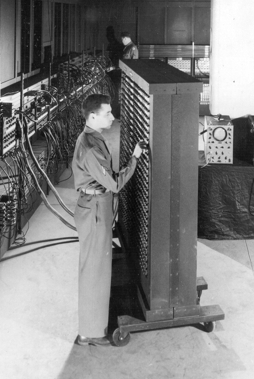ENIAC (nonfiction): Difference between revisions
No edit summary |
|||
| (4 intermediate revisions by the same user not shown) | |||
| Line 6: | Line 6: | ||
ENIAC was formally dedicated at the University of Pennsylvania on February 15, 1946 and was heralded as a "Giant Brain" by the press. It had a speed on the order of one thousand (103) times faster than that of electro-mechanical machines; this computational power, coupled with general-purpose programmability, excited scientists and industrialists alike. | ENIAC was formally dedicated at the University of Pennsylvania on February 15, 1946 and was heralded as a "Giant Brain" by the press. It had a speed on the order of one thousand (103) times faster than that of electro-mechanical machines; this computational power, coupled with general-purpose programmability, excited scientists and industrialists alike. | ||
On October 2, 1955, ENIAC was retired. After disassembly, parts were shipped to the Smithsonian for display. | |||
== In the News == | == In the News == | ||
<gallery | <gallery> | ||
File:ENIAC Empty-Noise-Into Alien-Communication.jpg|ENIAC ("[[Empty Noise Into Alien Communication]]") uses [[Gnomon algorithm]] techniques to visualize the [[Wow! signal (nonfiction)|Wow! signal]]. | File:ENIAC Empty-Noise-Into Alien-Communication.jpg|ENIAC ("[[Empty Noise Into Alien Communication]]") uses [[Gnomon algorithm]] techniques to visualize the [[Wow! signal (nonfiction)|Wow! signal]]. | ||
</gallery> | </gallery> | ||
| Line 16: | Line 18: | ||
* [[ENIAC (SETI)]] | * [[ENIAC (SETI)]] | ||
* [[Gnomon algorithm]] | |||
* [[Gnomon Chronicles]] | |||
== Nonfiction cross-reference == | == Nonfiction cross-reference == | ||
* [[ENIAC Programmers Project (nonfiction)]] | |||
* [[Turing completeness (nonfiction)]] | * [[Turing completeness (nonfiction)]] | ||
| Line 24: | Line 29: | ||
* [https://en.wikipedia.org/wiki/ENIAC ENIAC] @ Wikipedia | * [https://en.wikipedia.org/wiki/ENIAC ENIAC] @ Wikipedia | ||
* [https://boingboing.net/2019/06/21/founding-mothers-of-computing.html The ENIAC Programmers: how women invented modern programming and were then written out of the history books] @ Boing Boing: see [[ENIAC Programmers Project (nonfiction)]] | |||
* [http://eniacprogrammers.org/ ENIAC Programmers Project] | |||
[[Category:Nonfiction (nonfiction)]] | [[Category:Nonfiction (nonfiction)]] | ||
[[Category:Computers (nonfiction)]] | |||
[[Category:ENIAC (nonfiction)]] | |||
[[Category:Machines (nonfiction)]] | |||
Latest revision as of 16:52, 24 June 2019
ENIAC (Electronic Numerical Integrator And Computer) was amongst the earliest electronic general-purpose computers made.
It was Turing-complete, digital, and could solve "a large class of numerical problems" through reprogramming.
Although ENIAC was designed and primarily used to calculate artillery firing tables for the United States Army's Ballistic Research Laboratory, its first programs included a study of the feasibility of the thermonuclear weapon.
ENIAC was formally dedicated at the University of Pennsylvania on February 15, 1946 and was heralded as a "Giant Brain" by the press. It had a speed on the order of one thousand (103) times faster than that of electro-mechanical machines; this computational power, coupled with general-purpose programmability, excited scientists and industrialists alike.
On October 2, 1955, ENIAC was retired. After disassembly, parts were shipped to the Smithsonian for display.
In the News
ENIAC ("Empty Noise Into Alien Communication") uses Gnomon algorithm techniques to visualize the Wow! signal.
Fiction cross-reference
Nonfiction cross-reference
External links:

